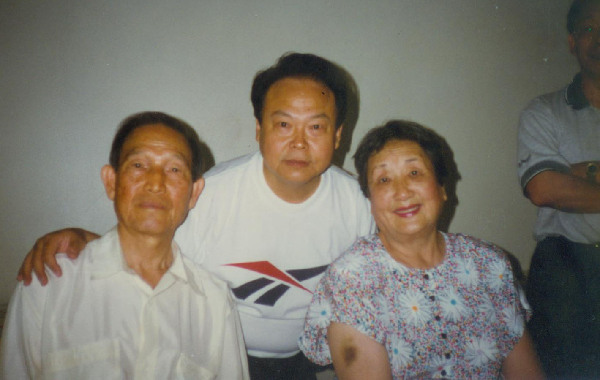Making Chinese opera an international music form
Updated: 2015-04-27 11:11
By Wen Zongduo,He Keyao(chinadaily.com.cn)
|
||||||||
 |
|
Liu Shiming and his teacher Wang Zefu and Wang’s wife in the United States in 1997[Photo provided to chinadaily.com.cn] |
A hard apprenticeship
Luck brought him to Wang Zengfu, a music teacher who specialized in laryngeal voicing and bel canto. "His first words at our first meeting were, ‘the young man’s short neck is fit for a tenor’," Liu recalled. "I followed him intensively for two years to cultivate my voice and lower my larynx, as required by Italian-style opera singing." His choice was rare in New China where most artists learned from Russian teachers.
Liu chose to live to the north of Beijing and exercised his vocal cords against the strong winds that battered the vast plain. "Several times blood came out of my throat and even my farmer neighbors pitied me. But I understood that the blood came because of overexertion, not the style of singing, so I had a short break and then started again." The pain was repaid with rapid progress that surprised both Wang, who now lives in the United States, and Guo, who is in Beijing.
"What Wang taught me was decisive to my career," Liu said.
For most of the "cultural revolution" (1966-76) period when opera came to a standstill, Liu spent spare time pondering Wang’s teachings and techniques in traditional music.
He turned to varied folk songs, and experimented with different parts of the upper register to achieve the perfect match of timber, tone and tune. "I spent 10 years pondering the qualities of bel canto with traditional opera and folk singing, as well as techniques in quyi and other folk song performances, constantly adjusting the frequencies of tone rising from my chest and the nasal and head cavities, and putting them together or separating them to fit different and flexible music."

 International rescue teams head to quake-hit Nepal
International rescue teams head to quake-hit Nepal
 World's deadliest earthquakes since 1900s
World's deadliest earthquakes since 1900s
 Rescuers deliver relief supplies on foot
Rescuers deliver relief supplies on foot
 China brings trapped nationals home from quake-hit Nepal
China brings trapped nationals home from quake-hit Nepal
 Severe drought hits Southwest China
Severe drought hits Southwest China
 History razed in Nepal earthquake
History razed in Nepal earthquake
 'Chi-pao teachers' found in Guangdong
'Chi-pao teachers' found in Guangdong
 Tourists evacuated from Nepal quake area arrive in Kunming
Tourists evacuated from Nepal quake area arrive in Kunming
Most Viewed
Editor's Picks

|

|

|

|

|

|
Today's Top News
Chinese, Koreans seek Japan apology
China rescue team starts work
Three US citizens among dead in avalanche after Nepal quake
Chinese rally across US to support NYC police officer under indictment
New publication will focus on China's energy industry
Abe's US trip: sense or sensibility?
China to overtake US in mobile gaming market
Nearly 2,500 confirmed dead in Nepal quake
US Weekly

|

|






